
Yaroslavl is a city and the administrative center of Yaroslavl Oblast, Russia, located 250 kilometers (160 mi) northeast of Moscow. The historic part of the city is a World Heritage Site, and is located at the confluence of the Volga and the Kotorosl rivers. It is part of the Golden Ring, a group of historic cities northeast of Moscow that have played an important role in Russian history. Population: 577,279 (2021 Census); 591,486 (2010 Russian census); 613,088 (2002 Census); 632,991 (1989 Soviet census).

The House of Demidov also Demidoff and Dimidov, was a prominent Russian noble family during the 18th and 19th centuries. Originating in the city of Tula in the 17th century, the Demidovs found success through metal products, and were entered into the European nobility by Peter the Great. Their descendants became among the most influential merchants and earliest industrialists in the Russian Empire, and at their peak were predicted to be the second-richest family in Russia, behind only the Russian Imperial Family whose net worth was around $300 billion. The Demidov family scattered to America, Italy, and other European countries as a result of the February Revolution of 1917.

The Leaning Tower of Nevyansk is a tower in the town of Nevyansk in Sverdlovsk Oblast, Russia, built in the 18th century. Its construction was funded by the blacksmith and industrialist Nikita Demidov and later his son Akinfiy Demidov, a famous Russian manufacturer and an associate of Peter the Great.

Arena 2000 is an arena, in Yaroslavl, Russia. It opened in 2001 and holds approximately 9,000 people. It is primarily used for ice hockey and is the home arena for Lokomotiv Yaroslavl team. It is also used for concerts, exhibitions and as a skating rink. It hosted the 2003 IIHF World U18 Championships.

The Rocky Steps are 72 stone steps leading up to the East entrance of the Philadelphia Museum of Art in Philadelphia that gained global fame after being featured in a notable scene from the 1976 film Rocky. In the scene, Rocky Balboa, an unpolished but ambitious boxer from South Philadelphia played by Sylvester Stallone, begins intense physical training after deciding to fight Apollo Creed, the World Heavyweight Champion. The scene is widely considered one of the most iconic in the history of modern films.

The Yaroslavl Demidov State University is an institution of higher education in Yaroslavl, Russia. In 1918, Yaroslavl Demidov State University became a successor university to the Demidov Lyceum, which was founded in 1803.
Timerevo is an archaeological site near the village of Bolshoe Timeryovo, seven kilometers southwest of Yaroslavl, Russia, which yielded the largest deposits of early medieval Arabic coins in Northern Europe.
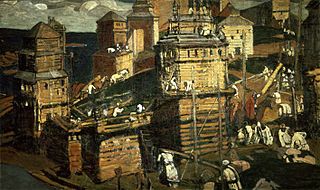
Sarskoye Gorodishche or Sarsky fort was a medieval fortified settlement in present-day Yaroslavl Oblast, Russia. It was situated on the bank of the Sara River, a short distance from Lake Nero, to the south of modern Rostov, of which it seems to have been the early medieval predecessor.
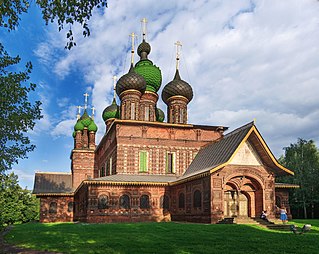
St. John the Baptist Church in Yaroslavl is considered to be the acme of the Yaroslavl school of architecture. It was built during 1671–1687 on the bank of Kotorosl river in the Tolchkovo sloboda (district) which at that time was the largest and wealthiest part of the town.

Neradin is a village in Serbia. It is situated in the Irig municipality, in the Srem District, Vojvodina province. The village has a Serb ethnic majority with a population of 551 people.
Berge or Berga was a Greek town of ancient Macedonia, in what is now the Serres regional unit in northern Greece.

Pavel Grigoryevich Demidov was a Russian traveller and patron of scientific education. He was from the Demidov family.

The Demidovsky Pillar is a modern obelisk on Demidov Square in the Central District of Barnaul, Russia. It is a memorial to 100 years of mining in the Altai Krai. It was begun on the initiative of Pyotr Kozmitch Frolov, with the first stone being laid on 18 June 1825 and completed in 1839.
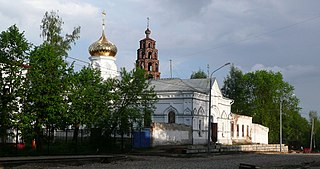
The Church of St. Nicetas is a Russian Orthodox church of St. Nicetas the Goth on Victory Street in Yaroslavl. It used to be the parish church of medieval Nikitskaya sloboda.
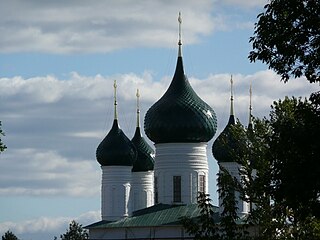
The Church of the Ascension of Christ is a four-piered penticupolar Orthodox church erected in Kondakovo, a western suburb of Yaroslavl between 1677 and 1682.

Toril is a municipality in the province of Cáceres and autonomous community of Extremadura, Spain. The municipality covers an area of 149.76 square kilometres (57.82 sq mi) and as of 2014 had a population of 176 people.
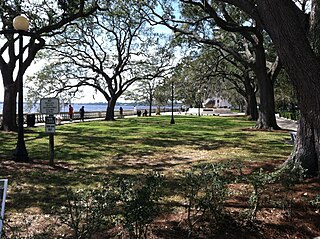
Memorial Park is a 5.85-acre (23,700 m2) public park, located on the St. Johns River in Riverside, one of the most historic neighborhoods near downtown Jacksonville, Florida. It is the third-oldest park in the city, and was listed on the National Register of Historic Places in 2017.
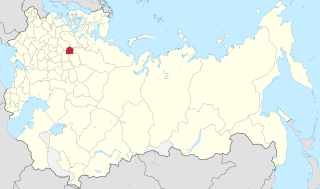
Yaroslavl Governorate was an administrative-territorial unit (guberniya) of the Russian Empire and the Russian SFSR, located in European Russia in the Upper Volga Region. It existed from 1777 to 1929; its seat was in the city of Yaroslavl.

The Reunification Monument marks the main entrance to Fælled Park from Trianglen in the Østerbro district of Copenhagen, Denmark. It was created by the artist Axel Poulsen, in collaboration with the architect Holger Jacobsen, to commemorate the reunification of Sønderjylland with Denmark in 1920.

Keisarinnankivi is a monument located at the Market Square in Kaartinkaupunki in central Helsinki, Finland. The monument, designed by Carl Ludvig Engel, is the oldest public monument in Helsinki. It was revealed with celebrations on the name day of Nikolai on 18 December 1835 to commemorate the first visit to Helsinki by Empress Alexandra Feodorovna, wife of Emperor of Russia Nicholas I. The monument was erected at the spot where the imperial couple stepped ashore from the steamship Ischora on arrival in Helsinki on 10 June 1833. The monument was funded by a national collection of funds and by a grant given by the Imperial Senate of Finland.

















